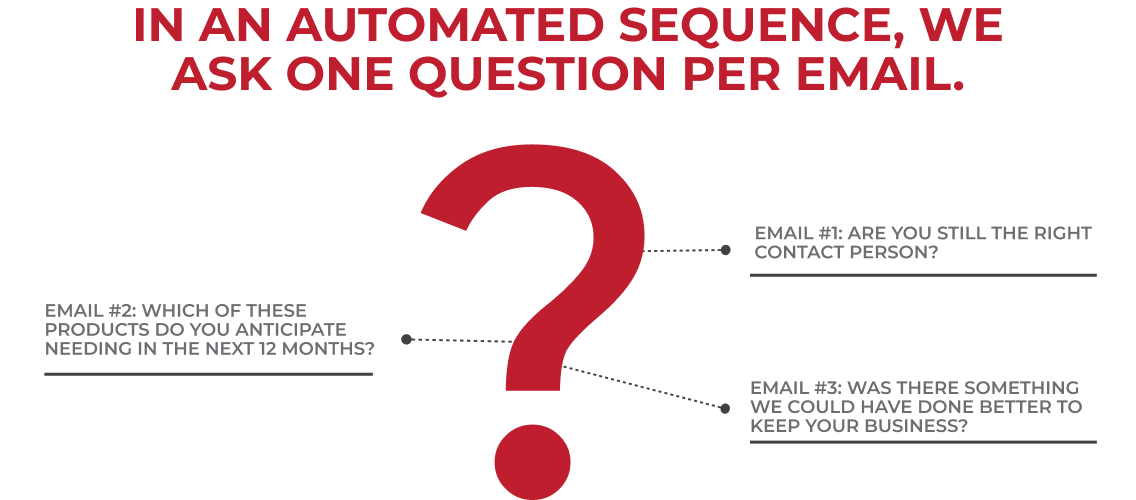Sales and marketing emails can boost brand awareness, nurture leads, and generate sales. But, they can also deepen your relationship with new customers and re-engage lapsed customers.
It’s time to start thinking about email in a new way.
See how we build a variety of email campaigns in this article below and learn why sales and marketing leaders don’t just need an email strategy—you need at least six.

- Newsletter
- Lead nurturing
- Transactional emails
- Cart abandonment
- Welcome New Customers
- Re-engage Lapsed Customers
Newsletter
The most common, regularly sent email is the traditional newsletter or e-newsletter. It can be sent quarterly, monthly, or even weekly, but it should always include value for the reader in the form of recommendations, upcoming events, success stories, or curated content related to their needs.
Unfortunately, the email newsletter is also the most widely abused form of outreach. The newsletter is an indication of how most B2B companies approach marketing content, in general. They write about what they know–themselves–instead of using the opportunity to deliver audience-centric value.
HOT TIP: Involve people throughout your company in content creation for your email newsletter. Customers and prospects will be very interested in hearing different perspectives regarding how you solve their problems.
Lead Nurturing
Very few B2B decision-makers can afford to be impulse buyers, especially when those decisions involve risk. That’s why their customer journey, from initial research through consideration and selection, lasts several months, if not over a year.
We map this journey out when building buyer personas. Understanding how customers move through their buying process helps us deliver relevant content—the right message to the right person at
the right time.
Fortunately, that content narrative can be automated via email, triggered by your prospect’s intent behavior and readiness to have a sales conversation.
Lead nurturing, particularly with MQLs at the top of the funnel, is a great example of playing the long-game. Automation technology is the secret to how companies can do more outreach with very little resources.
Transactional emails
Standard confirmation emails in response to a purchase, a contact form submission, or an event registration are common B2B best practices. But, like several of these campaigns, an ordinary transactional email offers an opportunity to exceed expectations.
Since transactional emails return some of the highest open rates of any B2B messages, you’re very likely to grab your audience’s attention. Use this platform to gather sentiment in the form of a one-question Net Promoter Score (NPS) survey or a Customer Satisfaction (CSat) survey. You can also share testimonials from satisfied customers or suggest the reader gets to know your team a bit better with a link to your website or a social media follow link.
Cart abandonment email w/offer
As consumers, we often change our minds before finishing an order or we get distracted while we’re shopping. Whatever the reasons, B2B decision-makers are the same.
For companies with an e-commerce website, an automated cart abandonment email reminds buyers to come back and it can help them pick right up where they left off.
Cart abandonment emails don’t have to include a discount, but if your analytics tell you an alarming number of buyers reach the checkout but don’t complete the transaction, you may want to
investigate potential barriers like shipping details, delivery availability, or the information required on your checkout form.

Welcome emails
The span of time after you agree to a deal and before the first point of engagement is what Andrew Davis calls “the honeymoon period.” An unexpectedly thoughtful email here can help to deepen your relationship with new customers.
We built a personal email message from one client’s Vice President into the customer experience in order to reinforce the company’s emphasis on personal service and the ability for customers to reach any person at any level directly. That message consistently generates a ##% open rate.
This extra touch says, “Your purchase might be over, but our relationship is just beginning. And this is what you can expect from us.”
We even extended this outreach to LinkedIn, where each new customer receives a video welcome message from one of the company’s employees.
Re-engagement emails
Every company loses customers at some point. But, what if some of those customers can be won back with a short, automated re-engagement campaign?
We’ve seen a three-email sequence successfully bring lapsed customers back to the table for one client, who also discovered a variety of reasons buyers disappeared in the process.
Our re-engagement campaign focuses on customers who have not made a purchase in the past six months, according to the company’s CRM.
CONCLUSION
Each of these email campaigns has an appropriate time and audience. But, all can be used by nearly any B2B organization that wants to think differently about email and wants its customers to think differently about them.
If You Enjoyed This Article, Check Out These….
Join Thousands Of
Like-Minded Folks
Receive monthly business growth tips
and event invites right to your inbox.




